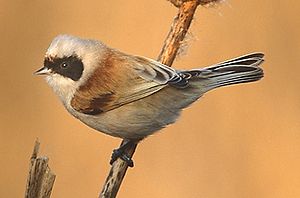Bag tit
| Bag tit | ||||||||||||
|---|---|---|---|---|---|---|---|---|---|---|---|---|

Tasmanian tit ( Remiz pendulinus ) |
||||||||||||
| Systematics | ||||||||||||
|
||||||||||||
| Scientific name | ||||||||||||
| Remiz pendulinus | ||||||||||||
| ( Linnaeus , 1758) |
The Beutelmeise ( Remiz pendulinus ) is a bird art from the family of the bag chickadees (Remizidae). Several subspecies are distinguished.
description
The bag tit can grow to be about 10 to 12 cm and weighs up to 20 g. The wings reach a length of about 60 mm. The most striking features are the gray head with the black mask and the rust-brown back. The young birds do not yet have a black mask. The bag tit is very similar in appearance to the red-backed shrike . The quiet call sounds something like "siüh".
distribution
The potty tit is a breeding bird of the boreal , temperate , Mediterranean , steppe and desert zones of the Palearctic . The area extends from south-west and west of Europe to China . The area is, however, very strongly fragmented in parts. The species was only widespread in Central Europe until around 1930 in eastern Central Europe. Since then, the breeding area has expanded in several, sometimes erratic, waves of propagation to the west and south-west of Europe. A high breeding success of the population through warm and dry summer months is probably responsible for the propagation waves. On the other hand, the spread of this species supports the increasing eutrophication of the landscape with an accompanying food supply such as an increase in the mealy plum aphid . Further spreading factors are the high rate of offspring due to successive polygeny and polyandry as well as renewed breeding attempts after sometimes very extensive breeding migrations. The emergence of human- influenced habitats such as lake areas and poplar plantings or transitional habitats such as gravel pits help the Beutelmeise continues to expand its breeding grounds.
From April to October, some bag-titans are short-range migrants in Eastern and Central Europe and migrate to the Mediterranean region in winter . Others stay in the Mediterranean all year round.
habitat

The habitat of the bag tit are semi-open wetlands . It is particularly in river lowland - and shore landscapes with staged wood structure and trees or high bushes drooping elastic branches encountered. Other important elements of their habitat are small reed and / or cattail and stinging nettles from the previous year . It also breeds on the edge of field trees and forest edges , if these have reeds, willow bushes and higher individual trees in a tiered sequence. Their breeding grounds are usually found in the outer area of the lower crown third of individual trees that tower over bushes or reeds .
nutrition
The potty tit looks for its food mainly on trees , bushes, shrubs and in the reeds . It feeds on insects , spiders and seeds .
Reproduction

Marsupial tits reach sexual maturity in their first year of life. The pair bond is only for a short time and lasts from nest building to egg laying. Both the male and the female are successively polygamous.
The breeding season extends from May to June. The male builds several fluffy, round nests close to the water from cobwebs , seed wool and plant fibers on drooping branches . The bag-shaped nest is about 17 cm high and 11 cm wide. The female chooses the best nest, helps with the final preparations and then lays five to eight eggs . The young hatch after about two weeks. The bag tit can have multiple partners. The European population is estimated at around one million breeding pairs.
Hazardous situation
The bag tit is included in the Red List of Endangered Species of the International Union for Conservation of Nature IUCN. Since the species has an extremely wide distribution area and a very large population with an increasing population trend, it is assessed as not endangered ( Least Concern ).
supporting documents
literature
- Hans-Günther Bauer, Einhard Bezzel and Wolfgang Fiedler (eds.): The compendium of birds in Central Europe: Everything about biology, endangerment and protection. Volume 2: Passeriformes - passerine birds. Aula-Verlag Wiebelsheim, Wiesbaden 2005, ISBN 3-89104-648-0 .
- Manfred Schönfeld: The bag tit. Remiz pendulinus. With a comprehensive overview of the Remizidae family . Die neue Brehm-Bücherei, Volume 599. Westarp-Wissenschaften, Magdeburg 1994, 264 S., ISBN 3-89432-410-4
Web links
- Videos, photos and sound recordings for Remiz pendulinus in the Internet Bird Collection
- Photos at www.naturlichter.de
- Entry at the Swiss Ornithological Institute
- Age and gender characteristics (PDF; 3.6 MB) by Javier Blasco-Zumeta and Gerd-Michael Heinze (English)
- Marsupial tit feathers
Individual evidence
- ↑ Bauer et al., P. 93
- ↑ Bauer et al., P. 94.
- ↑ Bauer et al., P. 95.
- ↑ Martin Flade: The breeding bird communities of Central and Northern Germany - Basics for the use of ornithological data in landscape planning . IHW-Verlag, Berlin 1994, ISBN 3-930167-00-X , p. 6.
- ↑ Remiz pendulinus in the endangered Red List species the IUCN 2009. Posted by: BirdLife International, 2009. Accessed on March 14 of 2010.

